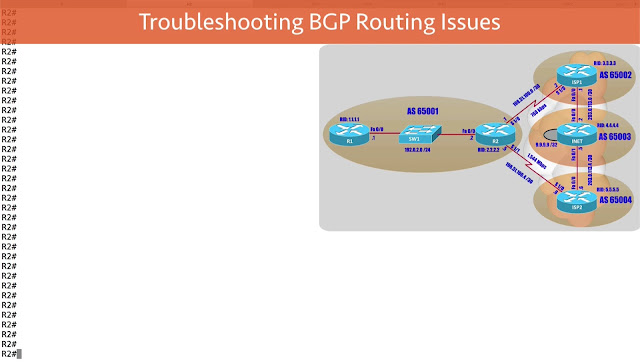 Now the we have considered some of the Troubleshooting issues
surrounding BGP, let’s now consider
Multi-Protocol BGP, Multiprotocol BGP allows us to support BGP Routing for IPv6
Now the we have considered some of the Troubleshooting issues
surrounding BGP, let’s now consider
Multi-Protocol BGP, Multiprotocol BGP allows us to support BGP Routing for IPv6
And
there is similar consideration to Troubleshooting Multiprotocol BGP as there
are Traditional BGP however, i want to use this topic to point out a couple of
differences and some extra things to keep in mind for one thing if Routing
IPv6, we need to make sure that the Router is
enabled for IPv6 unicast-routing, let’s do a
Ø R1(config)#ipv6
unicast-routing
Now we are
enabled for IPv6 and there is something else that’s not is obvious
going on here, we got a couple of ways setting this up, we could do IPv6 Routing over an IPv4 session or we could do
IPv6 Routing over an IPv6 session and
i want you to show you the Configuration for both and this topology, i have got an IPv4 session setup between Router R1 and R2,
let’s take a look at the Configuration.
Ø R1#show run | section
router
And you gonna see
this looks lot like, the EIGRP Named Configuration
or the Address-Families configuration for OSPF, that’s what we
have got here, we got an Address-family for IPv4
and we got another Address-family for IPv6. Notice we go into
Router BGP Configuration Mode similar to have we do with Traditional BGP or the
way we normally talk about Traditional BGP as being BGP Version 4.
Please understand this
is also technically BGP Version 4, it’s just that we have some extra extensions
added when we have Multiprotocol BGP but technically still Version 4 and i am specifying my neighbor and Remote Autonomous System
number and i am using IPv4 address to specify the neighbor when it comes to Troubleshooting though, here is the one
of first thing i want you to think about for your IPv6 Address-Family if you are doing this over an IPv4 session you need to
specify a Route-Map for that neighbor
That’s going to specify what next Hop IPv6 address it should use and
this is Next Hop information, note that Router R1 is using this is next
Hop-Router information, that R1 is telling to
Router R2, we are telling R2 how to get back to us, we are specifying ourselves, we specifying our IPv6 address, let’s take a
look at this Route-Map
Ø R1#show route-map
And you can see that, we are setting our IPv6 next-hop to 2000:2::1
and if you take a look at our topology that’s us,
we are telling Router R2 use this IPv6 Address to
get back to us if we don’t do
this then any Routes that we advertised to Router
R2 they are not gonna be injected into Router R2’s IP Routing Table because
Router R2 would not know how to get back to us, it would not
know how to get to the next-hop so, if we doing
this over an IPv4 session, we need to specify that Next-Hop.
And those are
couple of things to keep in mind if we doing IPv6 Routing over an IPv4 BGP
session and i want you to show you for contrast what a configuration looks like
if we doing IPv6 Routing over an IPv6 BGP session, i am going to update the configuration
on this topology right now, and we check that out.
In this
topology, i have got an IPv6 BGP session setup
between Router’s R1 and R2 and we are doing IPv6 Routing over
that IPv6 session and i wanted you to contrast
this configuration vs the configuration where we doing IPv6 Routing over IPv4
BGP session, let’s do a
Ø R1#show run | include
router
And here you see that
configuration is bit simpler, it still using this
address’s family approach but i am specifying as my neighbor an IPv6 address and notice that under the IPv6 address-family, there is no need to have a Route-Map Configured as we did a few movements ago when we had a IPv4 BGP
session.
Now this does not
mean we cannot do IPv4 Routing as well over BGP it’s just that we would have to
setup that separately and that would requires to have here adjacency that might not scale very well for very large network,
we get lots of neighbors each of which running IPv4 and IPv6 but in, some cases this is more efficient approach maybe you only want to do IPv6 Routing and If you do this is a fairly simple way to set
it up and we do not have to worry
about creating a Route-Map.
If You Like the Post. Don’t forget
to “Subscribe/Share/Comment”. Thank You



























